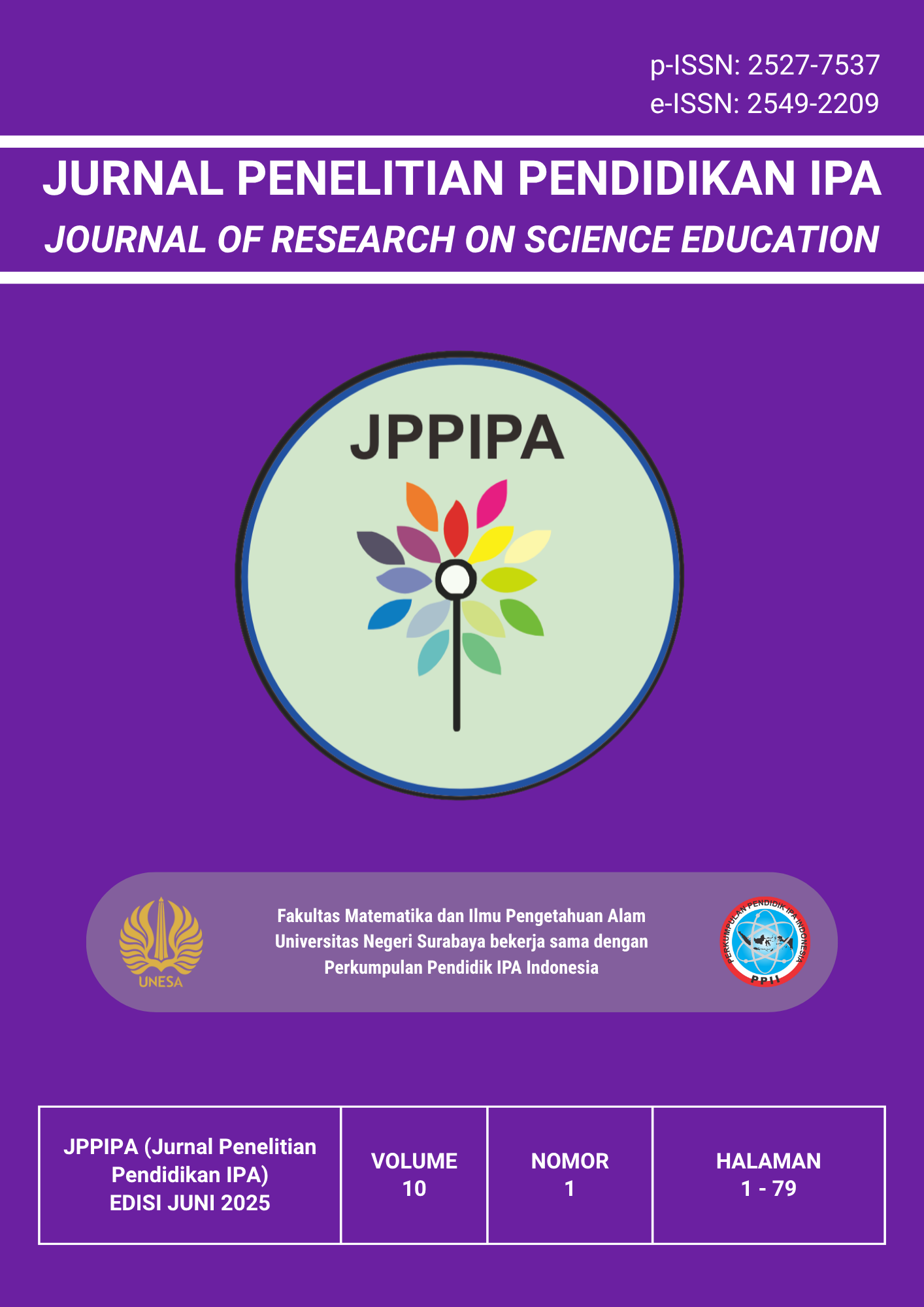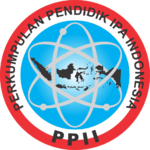ETHNOSCIENCE STUDY OF SHRIMP PASTE AT THE MERANTI ISLANDS AS A REPRESENTATION OF CHEMISTRY LEARNING
DOI:
https://doi.org/10.26740/jppipa.v10n1.p57-68Keywords:
Ethnoscience, Shrimp Paste, Representation, Chemistry LearningAbstract
This study explores the integration of ethnoscience into chemistry education by using the traditional shrimp paste production process in Meranti Islands Regency, Riau, Indonesia as a contextual learning resource. The research method used a qualitative descriptive case study approach, with data collection involving field observations, in-depth interviews with five shrimp paste producers (ethnographic data), and a review of scientific literature (scientific data). The findings indicate that the shrimp paste production process still heavily relies on inherited local knowledge and involves several stages: sorting and washing, crushing, molding, fermentation, drying, and heating over a fire. Each of these stages contains chemical aspects that can be analyzed through various approaches: a macroscopic approach (examining physical and chemical changes such as color, aroma, and texture), a submicroscopic approach (focusing on molecular and enzymatic interactions), and a symbolic approach (exploring chemical reactions such as hydrolysis, fermentation, and Maillard reactions). Furthermore, the study reveals that the community’s knowledge of the shrimp paste production process is supported by scientific principles, as documented in the literature. The results suggest that shrimp paste production not only contributes to the local economy and cultural preservation but also holds significant potential for enhancing students’ scientific literacy through an integrated chemical representation approach. The integration of these three levels of chemical representation is expected to provide students with a holistic and applied understanding of chemical concepts.
References
Agustina, N., Munzil, M., Habiddin, H., & Muchson, M. (2021). Development of guided inquiry based e-learning teaching material on the intermolecular forces enriched with molview. Journal of Disruptive Learning Innovation (Jodli), 2(2), 80. https://doi.org/10.17977/um072v2i22021p80-88
Akonor, P., Ofori, H., Dziedzoave, N., & Kortei, N. (2016). Drying characteristics and physical and nutritional properties of shrimp meat as affected by different traditional drying techniques. International Journal of Food Science, 2016, 1-5. https://doi.org/10.1155/2016/7879097
Al‐Balushi, S. and Al-Harthy, I. (2015). Students’ mind wandering in macroscopic and submicroscopic textual narrations and its relationship with their reading comprehension. Chemistry Education Research and Practice, 16(3), 680-688. https://doi.org/10.1039/c5rp00052a
Al-Fialistyani, D., Andayani, Y., Hakim, A., & Anwar, Y. (2020). Literasi kimia pada aspek kompotensi melalui pembelajaran inkuiri terbimbing dengan pendekatan etnosains. Jurnal Pijar MIPA, 15(5), 537-540. https://doi.org/10.29303/jpm.v15i5.2231
Andayani, Y., Hakim, A., Loka, I., & Mutiah, M. (2021). Kajian etnosain pakaian adat “lambung”: identifikasi konten kimia dalam tradisi masyarakat Lombok. Unesa Journal of Chemical Education, 11(1), 65-69. https://doi.org/10.26740/ujced.v11n1.p65-69
Borgers, B., Quinn, P., Degryse, P., Bie, M., & Welkenhuysen, K. (2019). Roman pottery production in civitas tungrorum, central belgium, during the first–third centuries ce. Archaeometry, 62(2), 267-284. https://doi.org/10.1111/arcm.12508
Cáceres, P., Peñas, E., Martínez‐Villaluenga, C., Amigo, L., & Frı́as, J. (2017). Enhancement of biologically active compounds in germinated brown rice and the effect of sun-drying. Journal of Cereal Science, 73, 1-9. https://doi.org/10.1016/j.jcs.2016.11.001
Chen, X., Goes, L., Treagust, D., & Eilks, I. (2019). An analysis of the visual representation of redox reactions in secondary chemistry textbooks from different chinese communities. Education Sciences, 9(1), 42. https://doi.org/10.3390/educsci9010042
Dewi, R. A., Santoso, U., & Wibowo, H. (2020). Partial properties of ready to use shrimp paste affected by heating time. CRBB Journal, 1(2), 57–61. https://crbb-journal.com/articles/vol-1-issue-2/CRBB-1(2)-2020-57-61.pdf
Dolgun, E., Dolgun, G., Aktaş, M., & Kılıç, F. (2020). Analysis of intermittent infrared drying using heat recovery with a novel control methodology. Journal of Food Process Engineering, 43(10). https://doi.org/10.1111/jfpe.13491
Fitria, Y., Darmansyah, D., & Zen, Z. (2023). Influence of problem based learning (PBL) models integrated information communication and technology (ICT) on mental models in primary school science learning. Jurnal Penelitian Pendidikan IPA, 9(10), 8941-8949. https://doi.org/10.29303/jppipa.v9i10.5490
Fransiska, S. (2022). Management of peatland fires based on local wisdom for sago farmers in Sungai Tohor, Tebing Tinggi Timur District, Meranti Islands Regency. Jurnal Agribisnis, 24(1), 127-142. https://doi.org/10.31849/agr.v24i1.7334
Gaffar, A., Umami, S. S., & Supardan, D. (2020). Bacterial pollution of a traditional terasi, shrimp paste rebon (Mysis relicta). Proceedings of the 2nd International Conference on Islam, Science and Technology (ICONIST 2019). 2nd International Conference on Islam, Science and Technology (ICONIST 2019), Mataram, West Nusa Tenggara, Indonesia. https://doi.org/10.2991/assehr.k.200220.026
Hajeb, P., & Jinap, S. (2012). Fermented shrimp products as source of umami in Southeast Asia. Journal of Nutrition & Food Sciences, 1(S10), Article 6. https://doi.org/10.4172/2155-9600.S10-006
Helmi, H., Astuti, D., Dungani, R., & Aditiawati, P. (2022). A comparative study on quality of fermented shrimp paste (terasi) of pelagic shrimp from different locations in indonesia. Squalen Bulletin of Marine and Fisheries Postharvest and Biotechnology, 17(1), 23-34. https://doi.org/10.15578/squalen.631
Helmi, H., Astuti, D., Putri, S., Sato, A., Laviña, W., Fukusaki, E., & Aditiawati, P. (2022). Dynamic changes in the bacterial community and metabolic profile during fermentation of low-salt shrimp paste (terasi). Metabolites, 12(2), 118. https://doi.org/10.3390/metabo12020118
Herawati, Rosita F., et al. 2013. Pembelajaran kimia berbasis multiple representasi ditinjau dari kemampuan awal terhadap prestasi belajar laju reaksi siswa SMA Negeri I Karanganyar tahun pelajaran 2011/2012. Jurnal Pendidikan Kimia Universitas Sebelas Maret, 2(2), 38-43.
Ho, F. (2019). Turning challenges into opportunities for promoting systems thinking through chemistry education. Journal of Chemical Education, 96(12), 2764-2776. https://doi.org/10.1021/acs.jchemed.9b00309
Ilyanie, Y., Faujan, N., & Muryany, M. (2023). Species identification of potential probiotic lactic acid bacteria isolated from Malaysian fermented food based on 16s ribosomal RNA (16s RRNA) and internal transcribed spacer (its) sequences. Malaysian Applied Biology, 52(4), 73-84. https://doi.org/10.55230/mabjournal.v52i4.c146
Keiner, L. and Graulich, N. (2020). Transitions between representational levels: characterization of organic chemistry students’ mechanistic features when reasoning about laboratory work-up procedures. Chemistry Education Research and Practice, 21(1), 469-482. https://doi.org/10.1039/c9rp00241c
Kim, Y., Choi, Y., Ku, S., Jang, D., Ibrahim, H., & Moon, K. (2014). Comparison of quality characteristics between belacan from brunei darussalam and korean shrimp paste. Journal of Ethnic Foods, 1(1), 19-23. https://doi.org/10.1016/j.jef.2014.11.006
Liu, Y., Wang, X., Xia, L., Li, J., Gao, S., & Li, D. (2022). Dynamic changes in the bacterial community and metabolic profile during low salt shrimp paste fermentation. Frontiers in Microbiology, 13, 887495. https://doi.org/10.3389/fmicb.2022.887495
López, J., Ah‐Hen, K., Vega‐Gálvez, A., Morales, A., García‐Segovia, P., & Uribe, E. (2016). Effects of drying methods on quality attributes of murta (ugni molinae turcz) berries: bioactivity, nutritional aspects, texture profile, microstructure and functional properties. Journal of Food Process Engineering, 40(4). https://doi.org/10.1111/jfpe.12511
Mahaffy, P., Ho, F., Haack, J., & Brush, E. (2019). Can chemistry be a central science without systems thinking? Journal of Chemical Education, 96(12), 2679-2681. https://doi.org/10.1021/acs.jchemed.9b00991
Murlida, E., Nilda, C., & Muzaifa, M. (2022). Chemical analysis and microbial population of belacan depik, fermented fish product of Rasbora tawarensis: International Conference on Tropical Agrifood, Feed and Fuel (ICTAFF 2021), Samarinda, Indonesia. https://doi.org/10.2991/absr.k.220102.018
Muzaifa, M., Murlida, E., Nilda, C., Rozali, Z., & Rahmi, F. (2023). Isolation and identification of protease producing bacteria from belacan depik, a traditional fermented fish of the Gayo tribe. IOP Conference Series Earth and Environmental Science, 1177(1), 012038. https://doi.org/10.1088/1755-1315/1177/1/012038
Pamungkaningtyas, F. (2023). Shrimp paste: different processing and microbial composition across Southeast Asia. IOP Conference Series Earth and Environmental Science, 1169(1), 012089. https://doi.org/10.1088/1755-1315/1169/1/012089
Pazicni, S. and Flynn, A. (2019). Systems thinking in chemistry education: theoretical challenges and opportunities. Journal of Chemical Education, 96(12), 2752-2763. https://doi.org/10.1021/acs.jchemed.9b00416
Pratama, F., Aznam, N., & Rohaeti, E. (2023). Study of chemical literacy related to chemical ethics based on local phenomena day-to-day: a case of used cooking oil. Jurnal Penelitian Pendidikan IPA, 9(9), 6810-6818. https://doi.org/10.29303/jppipa.v9i9.3224
Rahman, A., Astuti, R., & Sucipto, S. (2023). Quality properties of Indonesian traditional terasi: a review. Agrointek, 17(1), 224-239. https://doi.org/10.21107/agrointek.v17i1.15274
Riyadi, M., Setiawan, Y., Taufik, M., & Tanoto, P. (2022). Mapping of potential hazard areas for forest and land fire based on GIS in Kepulauan Meranti Regency, Riau. IOP Conference Series Earth and Environmental Science, 1030(1), 012014. https://doi.org/10.1088/1755-1315/1030/1/012014
Ryu, M., Nardo, J., & Wu, M. (2018). An examination of preservice elementary teachers’ representations about chemistry in an intertextuality- and modeling-based course. Chemistry Education Research and Practice, 19(3), 681-693. https://doi.org/10.1039/c7rp00150a
Sajriawati, S. (2022). Proses pengolahan terasi udang rebon skala rumah tangga di pesisir Pantai Lampu Satu. Nekton: Jurnal Perikanan dan Kelautan, 2(1), 35–42. https://ojs.poltesa.ac.id/index.php/nekton/article/view/123
Saha, G., Sharangi, A., Upadhyay, T., Al‐Keridis, L., Alshammari, N., Alabdallah, N., & Saeed, M. (2022). Dynamics of drying turmeric rhizomes (curcuma longa l.) with respect to its moisture, color, texture and quality. Agronomy, 12(6), 1420. https://doi.org/10.3390/agronomy12061420
Sang, X., Li, K., Zhu, Y., Ma, X., Hao, H., Bi, J., & Hou, H. (2020). The impact of microbial diversity on biogenic amines formation in grasshopper sub shrimp paste during the fermentation. Frontiers in Microbiology, 11. https://doi.org/10.3389/fmicb.2020.00782
Sarkar, T., Saha, S., Salauddin, M., & Chakraborty, R. (2021). Drying kinetics, fourier-transform infrared spectroscopy analysis and sensory evaluation of sun, hot-air, microwave and freeze dried mango leather. Journal of Microbiology Biotechnology and Food Sciences, 10(5), e3313. https://doi.org/10.15414/jmbfs.3313
Surya, R. and Nugroho, D. (2024). Supplementation of torch ginger (etlingera elatior) flowers improves the quality and safety of traditional fermented shrimp paste. Bio Web of Conferences, 98, 02001. https://doi.org/10.1051/bioconf/20249802001
Taber, K. (2013). Revisiting the chemistry triplet: drawing upon the nature of chemical knowledge and the psychology of learning to inform chemistry education. Chemistry Education Research and Practice, 14(2), 156-168. https://doi.org/10.1039/c3rp00012e
Talanquer, V. (2022). The complexity of reasoning about and with chemical representations. Jacs Au, 2(12), 2658-2669. https://doi.org/10.1021/jacsau.2c00498
Turmudi, T. (2023). Degraded peatlands and their utilization opportunities in Kepulauan Meranti Regency, Riau Province, Indonesia. Indonesian Journal of Geography, 55(3). https://doi.org/10.22146/ijg.84986
Van-Sertima, A., Simmons, S., Zablah-Vasquez, R., & Villalta‐Cerdas, A. (2024). Determination of chemical composition in tri-metal alloys: a three variable linear equation system approach. Educación Química, 35(1), 111-126. https://doi.org/10.22201/fq.18708404e.2024.1.86324
Wibowo, T. and Ariyatun, A. (2020). Kemampuan literasi sains pada siswa SMA menggunakan pembelajaran kimia berbasis etnosains. Edusains, 12(2), 214-222. https://doi.org/10.15408/es.v12i2.16382
Wu, M. and Yezierski, E. (2023). Investigating the mangle of teaching oxidation–reduction with the vischem approach: problematising symbolic traditions that undermine chemistry concept development. Chemistry Education Research and Practice, 24(3), 807-827. https://doi.org/10.1039/d2rp00321j
Yin, R. K. (2014). Case study research: design and methods (5th ed.). Thousand Oaks, CA: Sage Publications.
Downloads
Published
How to Cite
Issue
Section
 Abstract views: 323
,
Abstract views: 323
, PDF Downloads: 126
PDF Downloads: 126












